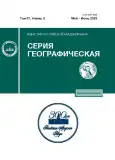The Structure of the Unified Energy System of Russia in the Post-Soviet Period
- Authors: Ataev Z.A.1
-
Affiliations:
- Yesenin Ryazan State University
- Issue: Vol 87, No 3 (2023)
- Pages: 348-357
- Section: ТЕРРИТОРИАЛЬНАЯ ОРГАНИЗАЦИЯ ОБЩЕСТВА
- URL: https://journals.rcsi.science/2587-5566/article/view/135588
- DOI: https://doi.org/10.31857/S2587556623030044
- EDN: https://elibrary.ru/QQUMPN
- ID: 135588
Cite item
Full Text
Abstract
The article examines the Unified Energy System of Russia from the point of view of its modern content and connectivity of structural parts. It is shown how the patterns of development of the USSR and Russia’s energy space are historically connected. The main attention is paid to the geographical analysis of changes in the industrial space of Russia, which determines the bet on factual information. The study revealed that there are three structural parts in the Unified Energy System of Russia. According to the criterion of the absence of electrical connections for parallel operation with other systems, a zone of technologically isolated (decentralized) energy systems is allocated, this is by definition the area of network incoherence. According to the criterion of synchronous operation (with a common frequency of electric current), two more spatial zones are allocated. The first synchronous zone includes six integrated power systems. Geographical analysis shows that elements of weak communication are inherent in all power systems and are produced by the transformation of the post-Soviet space. A pronounced defect of network incoherence is Kaliningrad oblast. The energy system of the South is based on the transit of electricity through the territory of Ukraine. The disconnection will reduce the stability of the European segment of the Unified Energy System of Russia, the risks of losing operational access to Transnistria, Moldova and the south-western segment of the European energy system are high. Therefore, capital-intensive network projects bypassing Ukraine are relevant. The energy system of the Urals provides the Center–Siberia link with transit through Kazakhstan and, as a consequence, network incoherence and the risks of losing access to Central Asia. The second synchronous zone of the Unified Energy System of Russia includes one unified energy system of the East, which operates in parallel, but not synchronously with the first zone (weak network connection). The energy system of the East has a narrow spectrum of intersystem communication, but it is very promising for integration with the energy system of China.
About the authors
Z. A. Ataev
Yesenin Ryazan State University
Author for correspondence.
Email: ataev-rzn@ya.ru
Russia, Ryazan
References
- Алаев Э.Б. Социально-экономическая география: Понятийно-терминологический словарь. М.: Мысль, 1983. 350 с.
- Атаев З.А. Географические основы локальной энергетики Центрального экономического района России: монография. Рязань: Ряз. гос. ун-т им. С.А. Есенина, 2008. 284 с.
- Атаев З.А. Изолированная энергосистема Калининградской области // Изв. РАН. Сер. геогр. 2018. № 1. С. 101–110.
- Бердин В.Х., Кокорин А.О., Юлкин Г.М., Юлкин М.А. Возобновляемые источники энергии в изолированных населенных пунктах Российской Арктики. М.: Всемирный фонд дикой природы (WWF), 2017. 80 с.
- Бондаренко А.Ф., Бутинг Г.Д., Ляшенков В.С., Маркун и др. Проблемы объединения энергосистем европейских стран // Электричество. 1991. № 11. С. 1–8.
- Горлов В.Н. Новые тенденции в пространственной организации электроэнергетики России // Социально-экономическая география: история, теория, методы, практика: Сб. научных статей. Смоленск: Универсум, 2011. С. 446–449.
- Данилова Е.В. Реформирование российской электроэнергетики (предпосылки и суть реформы) // Вестн. Томск. гос. ун-та. Томск: Национальный исслед. Томск. гос. ун-т, 2009. С. 274–277.
- Иванов А.В., Складчиков А.А., Хренников А.Ю. Развитие электроэнергетики арктических регионов Российской Федерации с учетом использования возобновляемых источников энергии // Российская Арктика. 2021. № 13. С. 62–80.
- Корнюхова А.В. Состояние, проблемы и перспективы развития электроэнергетики России // Вестн. Рос. ун-та дружбы народов. Сер.: Экономика. М.: РУДН, 2013. № 2. С. 49–60.
- Корчак Е.А. Арктическая зона России: социальный портрет регионов. Апатиты: Изд-во Кольского науч. центра РАН, 2017. 101 с.
- Мелентьев Л.А. Очерки истории отечественной энергетики (развитие научно-технической мысли). М.: Наука, 1987. 277 с.
- Народное хозяйство СССР в 1989 г.: Стат. ежегодник. М.: Финансы и статистика, 1990. 766 с.
- Орлов С.Л. Современное пространство России: новые подходы и концепции: монография. М.: Изд-во “Дашков и К”, 2022. 226 с.
- Подковальников С.В., Савельев В.А., Чудинова Л.Ю. Перспективы электроэнергетической кооперации России и стран Северо-Восточной Азии // Проблемы прогнозирования. 2015. № 4. С. 118–130.
- Проблемные регионы ресурсного типа: азиатская часть России / под общ. ред. В.А. Ламина, В.Ю. Малова. Новосибирск: Изд-во СО РАН, 2005. 386 с. (Интеграционные проекты СО РАН; Вып. 4).
- Ридевский Г.В. Пространственные структуры современной Беларуси: новая социально-экономическая география страны: Монография. Минск: БелНИИТ “Транстехника”, 2022. 244 с.
- Файбисевич Д.Л., Зейлигер А.Н. Влияние мощности и размещения электростанций на формирование энергосистем // Электрические станции. 1990. № 4. С. 16–20.
- Фомина А.В. Региональная экономика и территориальное распределение электроэнергетики Российской Федерации // Научно-технические ведомости Санкт-Петербургского политех. ун-та. Экономические науки. 2008. № 5 (64). С. 129–133.
- Хрущев А.Т. Избранные труды. Смоленск: Ойкумена, 2010. 320 с.
- Чайка Л.В. Пространственные аспекты развития электроэнергетики Европейского Севера России // Экономические и социальные перемены: факты, тенденции, прогноз. 2013. № 1 (25). С. 84–97.
- Энергетика XXI века: Условия развития, технологии, прогнозы / отв. ред. Н.И. Воропай. Новосибирск: Наука, 2004. 386 с.
- Энергетика СССР в 1986–1990 гг. / под ред. А.А. Троицкого. М.: Энергоатомиздат, 1987. 312 с.
- Украiна, промисловiсть та iнвестицiйна дiяльiсть: Атлас. Киiв: Iнститут геограii Украiни, Державне науково-вирониче пдприемство “Картографiя”, 2003. 78 л.
- Central-European interconnection of electricity networks ‒ proposal for an exercise. Meeting of experts on the problems of planning and operating large power systems. Geneva, Febr. 1990, UN ECE, EP/GE, 2 /R.78/A dd. 3.
- Situation and prospects of international interconnections. Meeting of experts on the problems of planning and operating large power systems. Geneva, Jan. 1990, UN ECE, EP/GE, 2/R.79/Add.2.
- Central-European interconnection planning and operation practices. Meeting of experts on the problems of planning and operation large power systems. Geneva, May 1990, UN ECE, EP/GE, 2/R.78/Add.2/Rev.
Supplementary files










